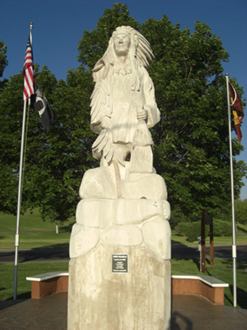Pocatello (Shoshone leader) facts for kids
Quick facts for kids
Pocatello
|
|
|---|---|
| Tondzaosha | |

Statue of Chief Pocatello, sculpted by J.D. Adcox
|
|
| Northern Shoshone leader | |
| Personal details | |
| Born | 1815 |
| Died | October 1884 (aged 68–69) |
| Known for | Namesake of city of Pocatello, Idaho |
Chief Pocatello (born 1815 – died October 1884) was a very important leader of the Northern Shoshone people. The Shoshone are a Native American group from the Great Basin area in western North America. His name in the Shoshoni language was Tondzaosha, which means "Buffalo Robe."
Pocatello led his people during a difficult time. Many settlers were moving into their lands. He tried to protect his people, sometimes by fighting. Later, he made peace with the U.S. Government. He then helped his people move to a reservation in Idaho. He worked hard to help the Shoshone survive after they were forced to leave their traditional lands. The city of Pocatello in Idaho is named after him.
Contents
Pocatello's Life and Leadership
Pocatello was born in 1815. He became a leader when the United States started expanding into the Utah area in the late 1840s.
Early Conflicts with Settlers
In the 1850s, Pocatello led attacks against groups of settlers. These settlers were traveling through the Utah Territory and along the Oregon Trail. He became known to Mormon leaders and government agents as a strong leader. Brigham Young, a leader of the Mormons, tried to make peace with the Shoshone. However, when the United States Army arrived in Utah in 1858, tensions grew worse.
Avoiding the Bear River Massacre
In January 1863, Pocatello learned that U.S. Army troops were coming. Colonel Patrick Edward Connor from Fort Douglas wanted to punish the Shoshone. Pocatello was smart and led his people away from danger. Because of his quick thinking, his people avoided the terrible Bear River Massacre.
After this, Pocatello sought peace with the Army. He agreed to stop attacking settlers. In return, he asked the government to pay for the land and animals that the settlers were taking.
The Fort Bridger Treaty
In 1868, Pocatello signed the Fort Bridger Treaty of 1868. In this agreement, he agreed to move his people to the Fort Hall Indian Reservation. This reservation was located along the Snake River. The U.S. government promised to give the Shoshone $5,000 worth of supplies each year. However, these supplies often did not arrive. This caused a lot of hardship and suffering for the Shoshone people.
Struggles and Seeking Help
By 1875, Pocatello's people were starving. He led them to a Mormon missionary farm in Corinne, Utah. He hoped that if his people became Mormons, their suffering would end. The missionaries did baptize the Shoshone. But the local white settlers did not welcome them. They wanted the Shoshone to leave. Because of this, the U.S. Army forced the Shoshone to return to the Fort Hall Reservation.
Railroad and City Naming
In the late 1870s, Pocatello allowed Jay Gould to build a railroad. This railroad, the Utah and Northern Railway, crossed the Fort Hall Indian Reservation. More and more settlers were coming to the Idaho Territory because gold had been discovered. The railroad helped these new settlers. The city of Pocatello, Idaho, which grew up along this railroad, was named in his honor.
Pocatello's Burial
Pocatello passed away in October 1884. His body was laid to rest in a deep spring in Idaho. His clothing, guns, knives, and hunting tools were buried with him. Eighteen horses were also sacrificed and placed into the spring on top of his body.
Understanding Pocatello's Name
For a long time, people wondered about the meaning of Pocatello's name. In 1918, a man named John E. Rees wrote about Idaho place names. He thought "Pocatello" meant "he does not follow the road." He believed this referred to the chief's "stealthy habits."
However, an earlier mention of "Pocataro" was in 1859. This was when F. W. Lander met Chief Pocatello. A linguist named Sven Liljeblad studied the Shoshoni language. He believed that Pocatello was not even a Shoshoni word. Chief Pocatello's daughter, Jeanette Lewis, agreed. She said the name had no meaning in her language. She confirmed that her father called himself Tondzaosha, which means "buffalo robe."
In Popular Culture
Pocatello is featured in the video game Sid Meier's Civilization V. He is a playable leader for the Shoshone Civilization in the game.
See also
 In Spanish: Pocatello (jefe shoshone) para niños
In Spanish: Pocatello (jefe shoshone) para niños

